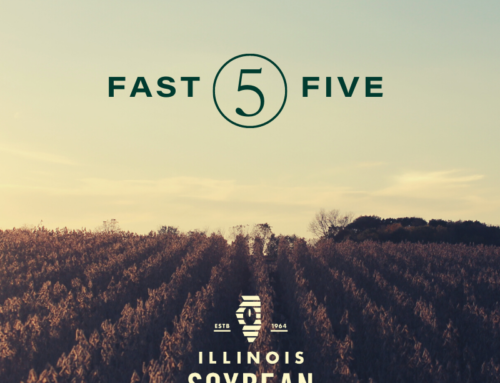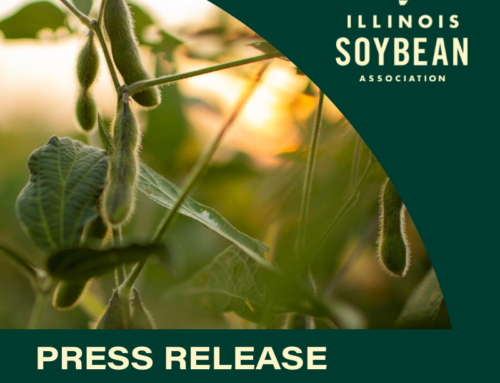To close out Fiscal Year 2024, Illinois Soybean Association (ISA) Market Development Committee members and staff attended Soy Connext in San Francisco, California. Each year, the U.S. Soybean Export Council (USSEC) hosts this flagship event to bring together buyers, exporters, and anyone in between to get business done.
ISA’s attendance to conferences like these allow our farmers and staff to gain access into rooms where decisions are made. This connects the interests of Illinois farmers with international customers and develops new or existing methods of utilization, increased value, and access to U.S. soy around the world. Industry experts and stakeholders joined American farmers, food, and agribusiness leaders to ignite collaborative ideas, discuss the geopolitical environment, elevate a preference for U.S. soy products, and differentiate the quality and value of U.S. soy from other products and origins.
This year, Soy Connext brought together over 750 attendees with more than 400 international customers across 62 countries to grow relationships and secure demand for U.S. soy. The conference’s coined phrase “Where Business Gets Done” rang true with over 530 individual meetings taking place between soybean buyers and exporters. ISA is able to play a key role in this event through hosting trade teams before and after Soy Connext to continue the conversation that promotes soy exports.
Presenters spoke to the economic impacts of soy, supply chain changes, and the future of sustainability. From market analyses to in depth discussions on research, those in attendance walked away with valuable information both for purchasing decisions and insight on marketing. While soy is often bought based on price or crude protein levels, research continues to show that U.S. soy is a premium product that increases operational efficiencies for livestock farms, feed mills and oil crushers. U.S. soy also introduces better flavor profiles in the soy foods sector and exemplifies on-farm stewardship and conservation efforts, giving it the lowest carbon footprint.
ISA’s presence saw a real impact with a variety of meetings and buyer touchpoints. We sat down with teams from China, Indonesia, Sri Lanka, Taiwan, the SASSA region, and Nigeria, and through each of these meetings, farmers and staff were able to share the benefits of buying soy from Illinois with its advantages in quality, reliability, and sustainability. More importantly, we were able to gain insight into their buying patterns and preferences that lead their decisions to buy from one location or another. These conversations are vital in the work we do to expand and develop markets as we learn of the market drivers for moving the needle forward.
Below, you’ll find more information about the speakers and topics featured at the conference:
Anja Manuel, Rice, Hadley, Gates & Manuel Cofounder and Partner, gave perspectives on navigating the intricacies and complexities of international markets.
David Mielke, Oil World Director, discussed complexities in the global soy industry and provided insights into current market developments and future trends in supply, demand and prices.
Chris Lambe, TASA Analytics Chief Operating Officer, led an exciting session on how sustainability is a driving force in many decisions.
Greg Martinelli, Greg Martinelli Ag Sales Professionals Owner, Author and Sales Coach, provided a new perspective encouraging sales teams to listen and anticipate customer needs—on both sides of the table—to improve relationships and maximize the bottom line.
Julie Ohmen, Soy Nutrition Institute CEO, led a discussion on how food trends and media messages don’t always reflect science. She challenged the audience to understand how trends and headwinds can translate to marketplace barriers and how science can be used to engage and respond.
Dwight Robinson, LA Grain President/CEO, discussed the complexity of global supply chains and how recent events have forced them to become more flexible. He gave a first-hand update on markets and adapting to meet consumer and exporter needs.
Flavia Damasceno, Wittaya Aqua Feed Formulation and R&D Specialist, provided compelling data underscoring why U.S. Soy is often referred to as the “gold standard” when it comes to consistency and nutrient composition compared to soy from different origins and what that means for buyers and end users.
Matthew Barry, Euromonitor International Insight Manager – Food & Beverage, and Yuhei Kudoh, Taishi Food Inc. Executive Vice President, spoke to the evolving demands of today’s consumers and the challenges presented as they prioritize sustainability, health and affordability in their food choices. The role of U.S. Soy in meeting their needs was forefront of the session.
Petya Sechanova, Covantis CEO, magnified the need for transparency in international trade and how grain trade has seized the opportunity to invest in strategies, modernize supply chain management and leverage the power of technology. She challenged the audience to consider how these advances benefit trade in emerging market economies.
Mark Shore, CME Group Director and Economist, gave an unlikely view of how the fracturing global financial system could lead to more stability in markets outside traditional Western influences, and how today’s fiscal environment might help or hinder business.
Jim Sutter, USSEC CEO, closed out the conference with comments on how data, analysis, insight and perspective come together at Soy Connext. He inspired attendees to consider connections that will move businesses toward goals that enable success in their markets and shared “5 Ps” that can help all of us in the year to come:
- Policies – With more elections happening around the world in 2024 than any other year, hopefully new leaders will bring opportunity and inspiration.
- Prosperity – People believe their countries’ economies and businesses are generally better. U.S. Soy growers may have the toughest situation in this regard given recent price action, but they are survivors and are accustomed to cyclical markets. The optimism from so many can translate into increased demand.
- Predictive Technology, or Generative AI, is changing how we do things and will continue to do so.
- Preserving – This is a critical effort that bears many names, but the common word seems to be sustainability.
- Partnership in many forms – Trade is best when done with other organizations or people with whom we have a partner-type relationship. This signifies the importance of partnering and trading with others around the world. We need to help educate the well-intended but misinformed voices that we hear communicating negative rhetoric about trade and globalization.

